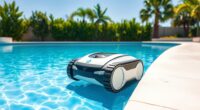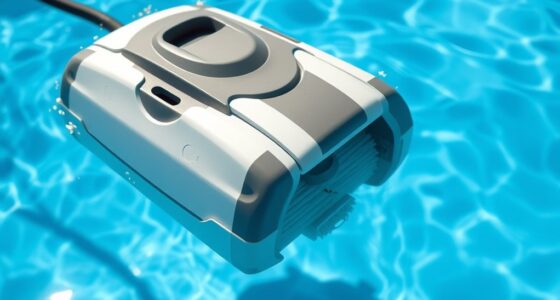Using suction pool cleaners in above-ground pools is generally easier and quicker to set up, with simpler installations and compatible fittings. In-ground pools often require more precise connections, adjustable suction, and consideration of wall surfaces for effective cleaning. Both types can keep your pool tidy, but the difference lies in complexity, coverage, and maintenance. To optimize your cleaning process and understand which option suits your pool best, explore more detailed tips and comparisons.
Key Takeaways
- Suction pool cleaners are compatible with both pool types but may require different fittings or connections for above-ground versus in-ground pools.
- Setup is typically simpler for above-ground pools, often involving straightforward hose attachment to existing skimmers or outlets.
- In-ground pools might need more precise installation and adjustable suction settings to navigate complex surfaces and obstacles.
- Cleaning efficiency depends on surface type; smooth surfaces are easier to clean, while textured or textured walls may require models with adjustable brushes.
- Maintenance costs and ease of use are generally lower for above-ground pools due to smaller size and simpler system requirements.
Compatibility With Pool Types
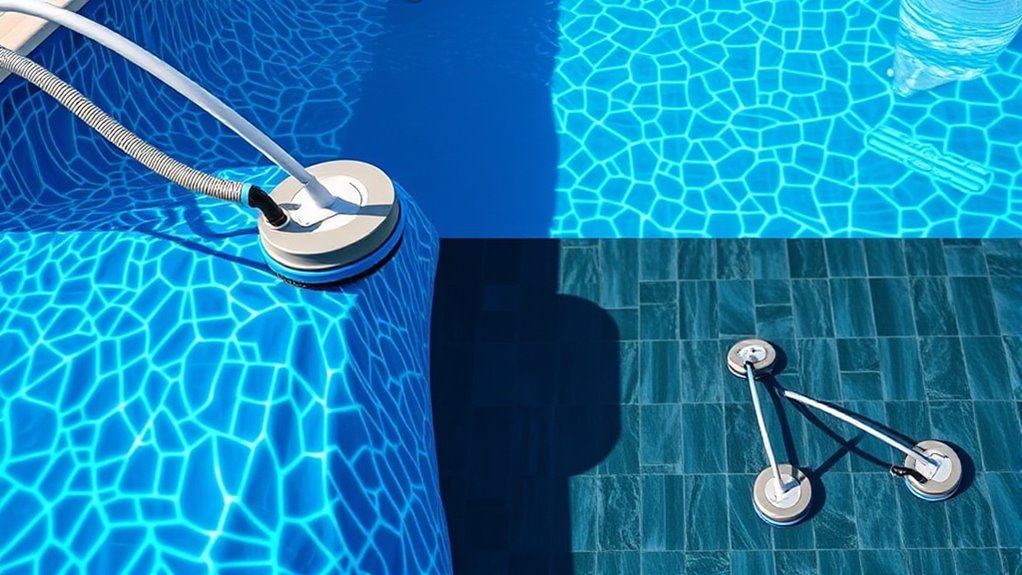
Suction pool cleaners are versatile tools that work well with most common pool types, but their compatibility can vary. When it comes to pool wall compatibility, these cleaners are generally effective in inground pools with smooth surfaces, but they might struggle with textured or vinyl walls. For above-ground pools, compatibility depends on the wall design and surface material. Skimmer integration is essential; some suction cleaners connect directly to your skimmer, making installation straightforward, while others require dedicated fittings or booster pumps. In-ground pools often support seamless skimmer attachment, ensuring efficient cleaning. Additionally, the wall surface material can influence the cleaner’s effectiveness, as rough or textured surfaces may impede movement or cleaning efficiency. However, always check your pool’s specific wall material and skimmer setup to confirm compatibility before purchasing a suction pool cleaner. Proper matching guarantees optimal performance and easier maintenance.
Installation and Setup Processes
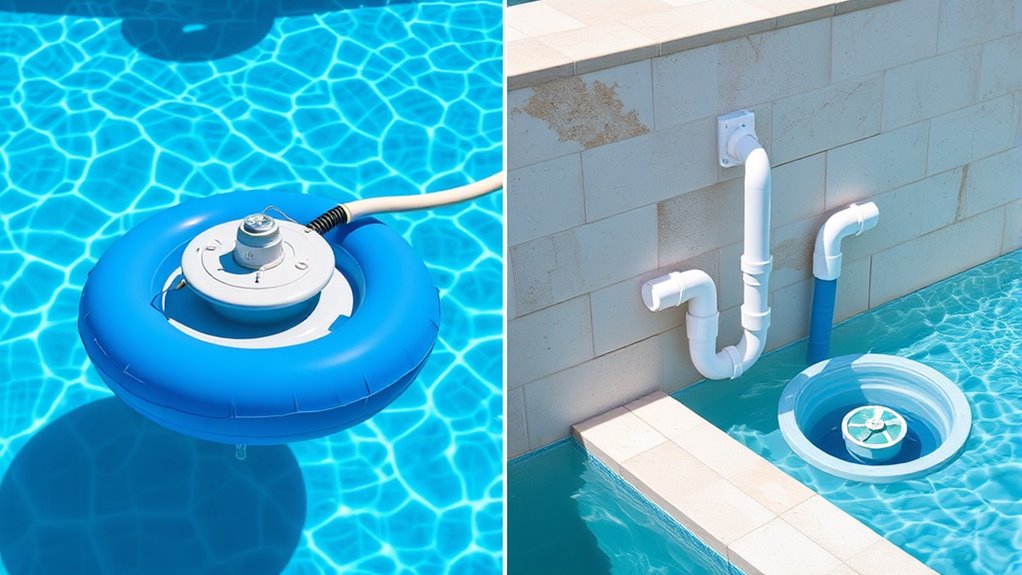
Installing suction pool cleaners can range from simple to more complex setups, depending on the model you choose. Some require just a few connections, while others need additional tools or adjustments. The setup time varies, so it’s helpful to know what to expect before you begin. Additionally, understanding the installation process for different types of pool cleaners can help ensure a smoother setup experience. Proper assembly and initial configuration are crucial steps that can impact the cleaner’s performance and longevity. For those interested in optimizing overall pool maintenance, considering tuning options like upgraded parts or settings can be beneficial. Being aware of industry standards can also guide you in selecting the most compatible and efficient cleaner for your pool. Moreover, familiarizing yourself with manufacturer instructions can prevent potential issues during installation.
Installation Complexity Differences
Have you ever wondered how the setup process differs between suction pool cleaners? In in-ground pools, installation can be more complex because you’ll need to connect the cleaner to dedicated skimmer or suction ports, which often require specific fittings based on the pool material. Above-ground pools, on the other hand, usually feature simpler setups, often just attaching the hose to the existing skimmer or outlet. Suction power is critical; in-ground pools typically require a unit with adjustable suction to handle different pool materials like vinyl, fiberglass, or concrete. This guarantees effective cleaning without damaging the surface. Overall, in-ground installation demands more precision and compatibility checks, while above-ground setups tend to be more straightforward and user-friendly.
Setup Time Variations
The time required to set up a suction pool cleaner varies considerably depending on the type of pool and your familiarity with the process. For in-ground pools, larger pool size and complex water chemistry may extend setup time, especially when balancing chemicals or adjusting suction levels. Above-ground pools usually require less time, but proper positioning is still essential. To streamline setup, consider these steps:
- Measure water chemistry to ensure ideal suction and cleaning efficiency
- Connect the hose securely, adjusting for pool size and water level
- Prime the cleaner to prevent airlocks, especially in larger pools
- Test the cleaner’s movement and suction to confirm proper operation
Being familiar with your pool’s size and chemistry helps reduce setup time and ensures effective cleaning.
Cleaning Efficiency and Coverage
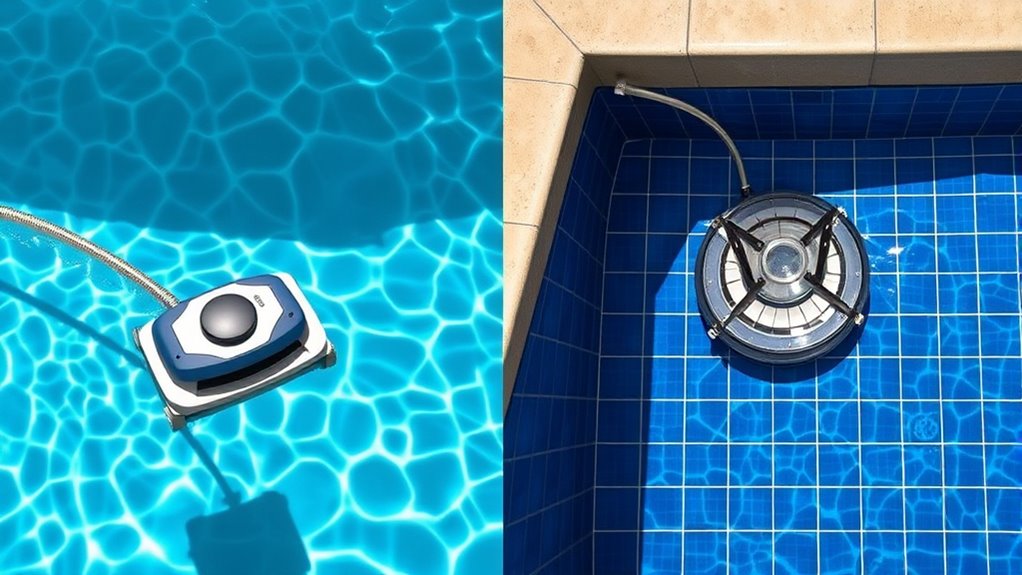
Your suction pool cleaner’s cleaning efficiency depends on how well it reaches different surfaces and navigates around obstacles. It may cover flat areas more thoroughly than tight corners or stairs, which can affect overall cleanliness. Variability in cleaning patterns means you might need to adjust settings or placement to guarantee thorough coverage. Additionally, the type of pool—above-ground or in-ground—can influence the cleaner’s ability to effectively cover all surfaces due to differences in design and accessibility, with preppy dog names often reflecting a more refined aesthetic that parallels the tailored features of in-ground pools.
Surface Accessibility Differences
Suction pool cleaners excel at removing debris from flat, accessible surfaces, but their ability to reach harder-to-access areas varies considerably. Surface access affects cleaning efficiency and coverage, especially in different pool types. In above-ground pools, the cleaner often has easier access to the entire surface, ensuring thorough debris removal. In contrast, in-ground pools may present obstacles like steps or corners that limit coverage. Consider these points:
- Flat surfaces allow for suitable debris removal.
- Narrow or curved areas may be missed or require multiple passes.
- Pool walls and corners can be challenging to clean thoroughly.
- Pool design impacts overall surface access and cleaning performance.
- Robotics integration in pool cleaning can help overcome some accessibility challenges, especially in complex in-ground pool layouts.
Understanding these differences helps you choose the right cleaner and maximize debris removal across your pool’s surfaces.
Obstacle Navigation Capabilities
Obstacle navigation considerably influences a suction pool cleaner’s ability to efficiently cover all areas of your pool. Your cleaner relies on obstacle detection and advanced navigation algorithms to maneuver around ladders, steps, and toys. Effective navigation ensures thorough cleaning without getting stuck or missing spots. The effectiveness of obstacle detection is often enhanced by sensor sensitivity, which impacts how well the cleaner detects obstacles. Additionally, proper navigation technology is essential for adapting to different pool shapes and obstacles.
Cleaning Pattern Variability
Cleaning pattern variability plays a crucial role in determining how effectively a suction pool cleaner covers your entire pool surface. If the pattern is inconsistent, some areas may remain dirty, especially in larger pools. To improve cleaning efficiency and coverage, consider these factors:
- Pool size: Larger pools require more extensive pattern coverage to prevent missed spots.
- Cleaner design: Some cleaners have randomized movement, reducing pattern variability.
- Water flow: Proper flow rates help maintain steady cleaning patterns across the surface and are essential for consistent coverage.
- Navigation features: Advanced models with better navigation minimize pattern variability, ensuring thorough coverage.
- Understanding cleaning pattern variability helps in selecting the most suitable cleaner for your pool size and shape, maximizing efficiency and coverage. Utilizing water flow management techniques can further optimize cleaning performance and reduce missed areas.
Cost and Budget Considerations
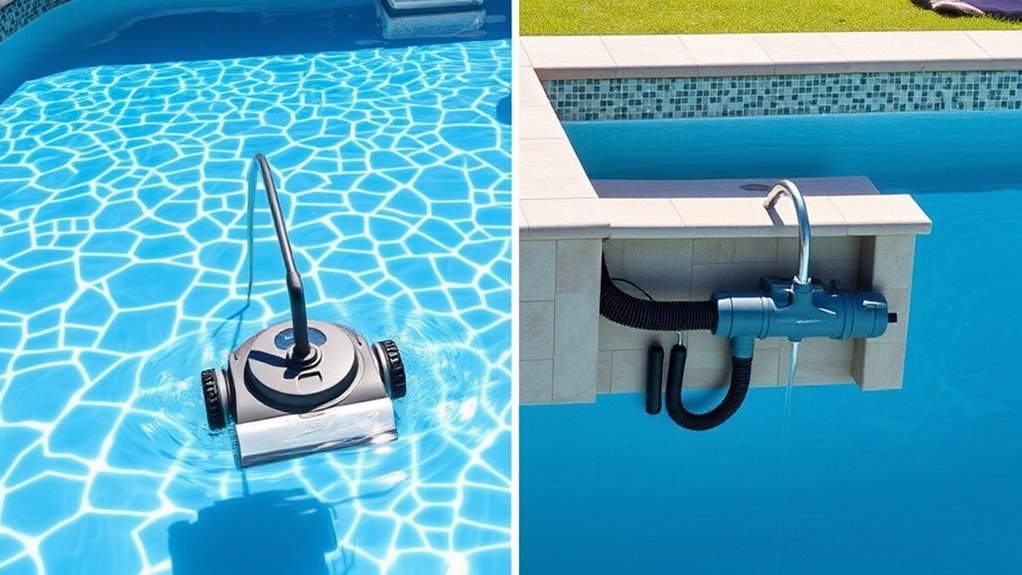
While suction pool cleaners are generally more affordable upfront than their robotic counterparts, it’s important to consider the ongoing costs that can add up over time. If you’re working within tight budget constraints, affordability considerations become crucial. In-ground pools tend to require larger, more powerful cleaners, which may lead to higher energy bills and replacement parts. Above-ground pools usually need smaller, less powerful models, reducing long-term expenses. Additionally, you should factor in costs for pool accessories, hoses, and potential repairs. By carefully evaluating your budget constraints, you can choose a suction cleaner that balances initial investment with ongoing expenses, ensuring you get effective cleaning without overspending. This approach helps you manage costs while maintaining a clean pool year-round. Considering the cost efficiency of different models can further help you make an informed decision that aligns with your financial situation. Evaluating the long-term maintenance costs can also provide a clearer picture of the true affordability of each option. Incorporating energy consumption considerations can further optimize your choice to reduce operational expenses over time, especially since energy efficiency can significantly impact ongoing costs.
Maintenance and Durability
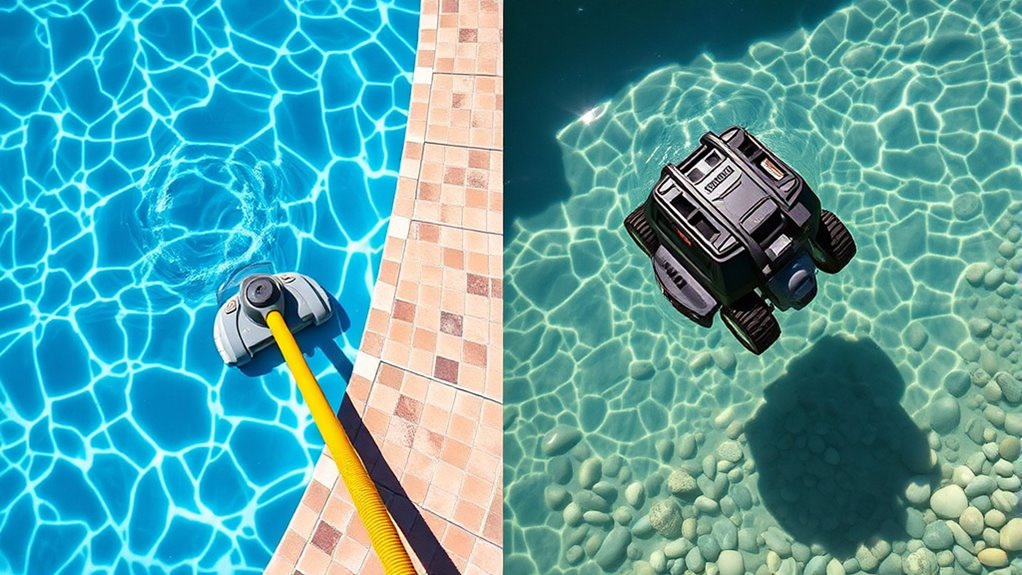
Regular maintenance is essential to guarantee your suction pool cleaner remains effective and lasts longer. Proper care minimizes durability concerns and keeps the filter working efficiently. To ensure peak performance:
Regular maintenance extends your pool cleaner’s lifespan and ensures optimal performance.
- Frequently clean the filter to prevent clogging and maintain suction power.
- Inspect hoses and connections for leaks or wear, replacing damaged parts promptly.
- Store the cleaner in a dry, shaded area when not in use to prevent unnecessary wear.
- Regularly check for debris buildup and clear it out to avoid strain on the motor.
- Follow manufacturer guidelines for airless paint sprayer maintenance to ensure optimal operation and longevity.
- Remember that pool maintenance routines play a vital role in extending the lifespan and efficiency of your suction cleaner.
- Manage replacement parts carefully to ensure compatibility and sustained performance over time.
- Using high-quality filter media can also improve the overall durability and effectiveness of your cleaner.
Pool Surface Compatibility

Choosing the right suction pool cleaner depends heavily on your pool’s surface type. If your pool has a smooth surface like fiberglass or vinyl, most cleaners will work efficiently. However, textured surfaces like pebble or rough plaster may require a cleaner with adjustable brushes or more aggressive scrubbing power. Your pool size also influences compatibility; larger pools need more powerful cleaners to cover the area effectively. The table below highlights key surface types and suitable cleaner features:
| Surface Type | Recommended Cleaner Features |
|---|---|
| Smooth (fiberglass, vinyl) | Standard suction with gentle brushes |
| Textured (pebble, plaster) | Adjustable brushes, stronger suction |
| Concrete | Heavy-duty brushes, robust build |
| Fiberglass | Soft brushes, gentle on surface |
| Vinyl | Mild suction, gentle brushes |
Matching your pool’s surface and size guarantees ideal cleaning. Properly matching your cleaner to the surface can also help extend its lifespan and improve cleaning efficiency, aligning with the importance of pool surface compatibility. Additionally, selecting a cleaner designed for electric power generation can enhance energy efficiency during operation. A good understanding of cleaner maintenance can further optimize performance and longevity.
Ease of Use and User Experience

Ease of use is a crucial factor when selecting a suction pool cleaner, as it directly impacts how quickly and effortlessly you can maintain your pool. For larger pools, especially in-ground ones, you’ll want a cleaner with strong suction power that handles the bigger pool size without hassle. Here are some key points to consider:
- Setup complexity: Choose a model that’s simple to install and start using.
- Navigation: Opt for cleaners that easily maneuver around obstacles and corners.
- Maintenance: Select a unit with straightforward debris removal and filter cleaning.
- Adjustability: guarantee it can adapt to your pool size and suction power needs for maximum performance.
A user-friendly cleaner saves time and effort, making pool maintenance less of a chore.
Energy Consumption and Operating Costs
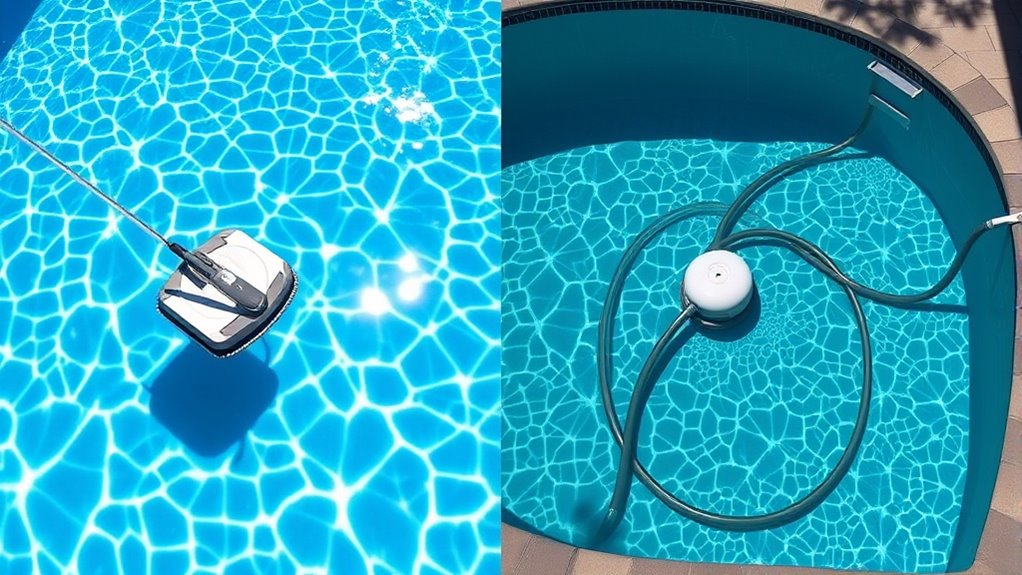
Since energy costs can substantially impact your pool maintenance expenses, it’s important to take into account the energy consumption of suction pool cleaners. Above-ground models often consume less energy than in-ground versions, leading to noticeable energy savings over time. This reduced consumption helps lower your overall operating expenses, making them more cost-effective in the long run. However, the efficiency of your cleaner also depends on factors like pool size and usage frequency. Choosing a model with energy-efficient features can further reduce power use without sacrificing cleaning performance. Keep in mind that while initial costs might be higher for some advanced units, the energy savings and lower operating expenses can offset these expenses over time, making your pool maintenance more affordable.
Specific Features and Technological Advances
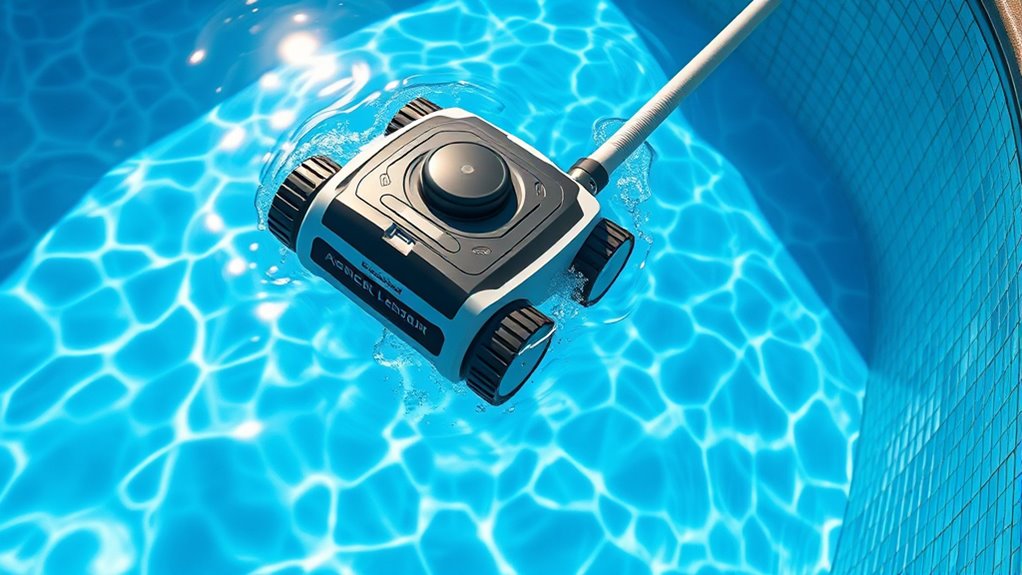
Advancements in suction pool cleaner technology have considerably enhanced their efficiency and user convenience. Modern models feature smarter navigation, allowing for better coverage of your pool’s surface. Here are some key innovations:
Modern suction pool cleaners offer smarter navigation and longer-lasting filters for easier, more efficient pool maintenance.
- Improved filter systems reduce the frequency of filter replacement, saving you time and money.
- Longer battery life in cordless models means more cleaning per charge, especially useful for above-ground pools.
- Enhanced debris sensors ensure thorough cleaning by detecting dirt and adjusting suction power accordingly.
- Wireless connectivity offers remote control and scheduling, giving you more control over cleaning sessions.
These technological advances make maintenance easier and extend the lifespan of your cleaner, ensuring you get ideal performance with less hassle.
Frequently Asked Questions
Can Suction Pool Cleaners Be Used With Saltwater Pools?
Yes, suction pool cleaners are generally saltwater compatible, but you should verify the manufacturer’s specifications to be sure. Saltwater pools can cause corrosion over time, so maintenance considerations include inspecting and cleaning your cleaner regularly. Using a saltwater-compatible model helps ensure durability, and maintaining proper water chemistry reduces wear. With the right cleaner and routine upkeep, you can keep your pool sparkling without issues.
How Do Suction Cleaners Perform on Irregularly Shaped Pools?
When cleaning irregularly shaped pools, suction cleaners can handle the unique contours, but you might face some cleaning challenges. These cleaners work well if their design accommodates nooks and crannies, ensuring thorough coverage. However, you’ll need to position the hose properly and sometimes manually guide the cleaner over complex areas. Overall, with proper setup, suction cleaners can effectively maintain irregular pool shapes, reducing your cleaning effort.
Are There Specific Safety Precautions for Above-Ground Pools?
When it comes to pool safety, you should always supervise children, guarantee proper cover installation when not in use, and regularly check your pool’s equipment. For above-ground pools, make sure the ladder is secure or removed when unoccupied to prevent accidents. Keep the area clear of debris, and install safety fencing if needed. These precautions help prevent injuries and keep your pool area safe for everyone.
What Is the Typical Lifespan of a Suction Pool Cleaner?
The proof of the pudding is in the eating, so your suction pool cleaner’s lifespan depends on how well you maintain it. Typically, you can expect it to last 3 to 8 years with regular maintenance. Keep up with cleaning and check for wear and tear to avoid costly replacements. Proper care minimizes replacement costs and guarantees your cleaner stays efficient, saving you money and hassle in the long run.
Can Suction Cleaners Be Used During Pool Openings and Closings?
You can definitely use suction pool cleaners during pool openings and closings, as part of your pool maintenance routine. They help keep your pool clean and reduce debris buildup during the season. Just guarantee you adjust your cleaning schedule accordingly, especially if you’re opening or closing your pool, to maintain ideal water quality. Regular use during these times ensures your pool stays in top shape and minimizes long-term maintenance needs.
Conclusion
Think of choosing a pool cleaner like picking the perfect pair of shoes—you want comfort, durability, and the right fit. I once saw a homeowner struggle with an in-ground cleaner that couldn’t handle their above-ground pool’s surface, like trying to run in shoes too tight. By understanding your pool type and needs, you’ll find a cleaner that glides smoothly, saving you time and money. Make the right choice, and your pool will sparkle effortlessly, just like a polished gemstone.

